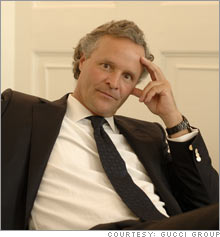Managing top talent at Gucci GroupNaysayers doubted the move from frozen foods to luxury fashion, but three years later the Gucci Group CEO's style of management has helped the company flourish, says Fortune's Jia Lynn Yang.(Fortune Magazine) -- When Robert Polet jumped from Unilever's ice cream and frozen-foods division to the top of the Gucci Group in 2004, Women's Wear Daily quipped, "What do frozen fish and ice cream have to do with $8,000 crocodile handbags?" Besides being an outsider, Polet (pronounced po-LET) had to take the reins after superstar designer Tom Ford had exited the flagship brand. It all raised the question: Could a marketer of Klondike bars manage the personalities of Gucci Group's remaining star designers, like Stella McCartney and Alexander McQueen?
Turns out Polet, who is of Dutch origin and works out of Gucci's London offices, had a trick or two up his well-tailored sleeve. Operating income last year rose 44 percent, and some previously lagging brands, like Balenciaga and Bottega Veneta, are turning a profit ahead of schedule. Checking in with Fortune from the men's fashion shows in Milan, Polet shared his tips for marrying art and commerce. Make the brand, not the talent, the star. In the late 1990s, Gucci's lead designer, Tom Ford, engineered a legendary turnaround of the label - and became an A-list celebrity in the process. But now Polet says it's crucial to promote the product, not the personality behind it, since the brand can outlive a designer or a manager. So he picks creative directors with strong opinions but with a clear focus on making great goods. "The designer works in the service of the brand," he says. Assign a business (and a creative) manager to each brand. The Gucci Group has ten brands under its umbrella, including Yves Saint Laurent and Boucheron. Previously, creative control of individual brands was concentrated at the top of the Gucci Group (Charts), but when Polet took over, he installed a two-person team to run the labels: a creative director to lead the vision and a CEO who works as the "business partner in the marriage." That way, he says, the products achieve the right look but also have the right merchandising strategy. "It's not creativity for creativity's sake," he says. Don't micromanage. Unlike his predecessors, Polet leaves virtually all design decisions to the designers. Where he exerts control is in selecting the right leaders, setting three-year business plans for each division, and creating what he calls the "rules of the game," a two-page description of what's allowed and what's not. "Then we actually say to the teams, 'Go for it.'" says Polet. "It's about the art of letting go." From the July 23, 2007 issue
|
Sponsors
|

